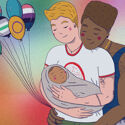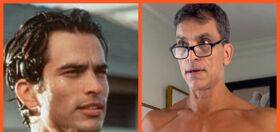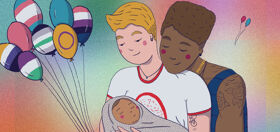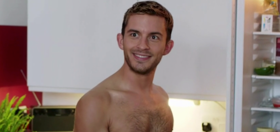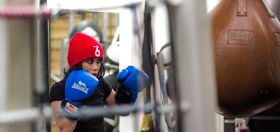
If you live in San Francisco, you’ve probably seen a hundred images just like the one above, featuring ripped abs, cute skivvies, and predominant whiteness. While these folks are clearly enjoying themselves, if you see this representation over and over (almost exclusively!) what do you get?
An entire community of people who feel like this body is a prerequisite to participate in spaces and events like the Santa Skivvies Run, a fundraiser for HIV/AIDS prevention and care.
Since “yucking their yum” goes against my better judgment as a counselor, I’ll use this platform to bring awareness to the fact that most opportunities to fundraise for marginalized communities are not inclusive of people with disabilities or a variety of body types. What’s even more complex is the fact that the funds raised often go towards disabled people (HIV/AIDS can become disabling), yet disabled people aren’t even given space in their own fight.
Take a look at most fundraising events in your area and you’ll notice that they are typically physically demanding and incredibly inaccessible.
How about we take this to the next level?
Our newsletter is like a refreshing cocktail (or mocktail) of LGBTQ+ entertainment and pop culture, served up with a side of eye-candy.
For example, thousands of people each year participate in AIDS/LifeCycle, a week-long, 545-mile bike ride from SF to LA. As a physically disabled person, I want to be able to participate in fundraising efforts like this, but unfortunately, most organizations aren’t willing or prepared to do the work it takes to make these spaces accessible.

In 2017, I decided to create the space for myself, and participate in the Santa Skivvies Run for the first time. And to make it even better, I decided to do it all on one rollerblade. In collaboration with event organizers, I was able to advocate for a more accessible route, avoiding major hills and shortening the distance so that I could participate, creating a lasting framework that the organization could use in the future for other disabled participants.
Through my participation, I wanted to show that not only can disabled people fundraise with the best of them (once the space is made accessible), but also that a diversity of bodies deserve the opportunity to feel beautiful, sexy, campy, and fun. As Laverne Cox has said of herself, I set out to position myself as a “possibility model” for other queer, disabled people who rarely see themselves represented in these spaces.
The response to my work was incredible. I raised $3,600 in my first year fundraising, receiving support from nearly 100 donors and earned the #2 spot in the top solo fundraisers list. Most importantly, my platform lifted up the principles of disability justice and a hope to increase body diversity in the event. It was clear I could rally my community around the principles of disability justice and body positivity, so I set out to lift up others in my community to share in this feeling of empowerment and experience similar success.

For Santa Skivvies Run 2018, along with 11 of my dearest disabled friends, allies and body positivity role models, I created the first-ever Disabili-Team. As the fundraising results were revealed, it was announced that together, Disabili-Team had raised almost $10,000, making us one of the highest fundraising teams in the history of the event.
Advocating for access is no cake walk (or Run, shall we say). Many people I encounter in my advocacy work seem to have an extremely reductive assumption of how advocating for accessible spaces happens. I imagine they picture me as a spiritual successor to Mary Poppins (watch out, Emily Blunt) who sees inaccessible spaces in the world, calls them out with a big smile, waves my magic nub and everything immediately becomes more accessible. Sadly a spoonful of sugar does nothing to make this medicine go down… and by medicine, of course, I mean the dismantling of ableist environments.
One of my mentors, Cathy Kudlick, once said the biggest enemies of disabled folks are “spontaneity” and “anonymity.” Those words unfortunately continue to ring true at every turn I face in my work of making spaces more inclusive. If our Disabili-Team just rolled up somewhere, we would be taking a big gamble in assuming that the event organizers would be prepared for our bevy of strengths and challenges. Most spaces inherently exclude people with disabilities, particularly a group with a range of impairments and access needs, making spontaneity basically impossible.
Even when people are eager to support inclusivity, historically I have felt the onus of the advocacy work fall on my shoulders as the “resident expert.” On the one hand, I am the expert on my own experience; allies turning to me for guidance and advice empowers me to advocate for what I need, rather than them making blunders based on generalizations, assumptions, and (my favorite) “disability sensitivity trainings.” On the other hand, there’s a certain indignity about having to do the majority of the work in making a space accessible for yourself.
It’s exhausting enough to bear the brunt of a system of oppression…it’s another to be expected to dismantle it while you’re at its mercy.
While I’m so incredibly happy to be surrounded by a community that is ready and willing to support efforts to make these spaces more accessible, I’m still stuck feeling as though the work won’t get done if I’m not the one to do it. And while this feeling won’t prevent me from twirling my way through these ableist environments, tap dancing with penguins as I go, I am ready for community members and allies to start taking the lead themselves. It’s time for all of us to start taking ownership over the accessibility of our spaces, so that the people who are already dealing with this lack of access every day, don’t have to do your work too.
I want to give a huge shout out to Marc & Melanie at San Francisco AIDS Foundation, who were both responsive, supportive, attentive, and affirming throughout the entire process of making Santa Skivvies Run more accessible. They put everything I suggested into action without much need for reminding or resistance and I felt so grateful to have their support.
Ultimately, participating in Santa Skivvies Run this year with Disabili-Team was an empowering, invigorating, and affirming experience. I am grateful for the privilege and community support that enabled me to carve out space for myself and others, all sharing the spotlight and basking in each other’s shine. On the Run, one of my teammates described the experience as “joyous” and I couldn’t have said it better myself.
Together, we pranced and danced our way through the route, crossing the finish line arm in arm, smiling from ear to ear. We were full of diverse bodies and abilities, and each member did such an incredible job at not only raising money but making the space we created together inclusive, idyllic and filled with love.
It is rare that I get to unconditionally celebrate my identity as a queer disabled person and my Disabili-Team offered me the solidarity to confidently and authentically strut alongside them. Normally the Castro is the last place I feel comfortable showing off body and feeling my oats in some femme flair. With my teammates by my side, I rocked my big, fluffy coat and plenty of skin like a true Cold-chella Queen.
I couldn’t be happier with what we were able to accomplish together and I hope that this is only the beginning of a tradition that inspires others to recognize the power of cross-movement solidarity and celebrating interdependence.
If I learned anything from this experience, it’s this: I may only have one leg to stand on, but I have an amazing community to lean on for support.
Alex Locust is a proud, biracial “glamputee” spreading the word about social justice, one workshop at a time. Whether on the runway or in a counseling session, Alex aspires to embody the tenets of disability justice and fiercely advocates for equity in all community spaces. You can follow Alex’s work by following him on Instagram (@glamputee), checking out the resource guides on his website (www.glamputee.com), or by email at [email protected].


